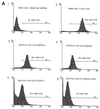Cross-reactivity between the rheumatoid arthritis-associated motif EQKRAA and structurally related sequences found in Proteus mirabilis
- PMID: 10338479
- PMCID: PMC96580
- DOI: 10.1128/IAI.67.6.2769-2775.1999
Cross-reactivity between the rheumatoid arthritis-associated motif EQKRAA and structurally related sequences found in Proteus mirabilis
Abstract
Cross-reactivity or molecular mimicry may be one of the underlying mechanisms involved in the etiopathogenesis of rheumatoid arthritis (RA). Antiserum against the RA susceptibility sequence EQKRAA was shown to bind to a similar peptide ESRRAL present in the hemolysin of the gram-negative bacterium Proteus mirabilis, and an anti-ESRRAL serum reacted with EQKRAA. There was no reactivity with either anti-EQKRAA or anti-ESRRAL to a peptide containing the EDERAA sequence which is present in HLA-DRB1*0402, an allele not associated with RA. Furthermore, the EQKRAA and ESRRAL antisera bound to a mouse fibroblast transfectant cell line (Dap.3) expressing HLA-DRB1*0401 but not to DRB1*0402. However, peptide sequences structurally related to the RA susceptibility motif LEIEKDFTTYGEE (P. mirabilis urease), VEIRAEGNRFTY (collagen type II) and DELSPETSPYVKE (collagen type XI) did not bind significantly to cell lines expressing HLA-DRB1*0401 or HLA-DRB1*0402 compared to the control peptide YASGASGASGAS. It is suggested here that molecular mimicry between HLA alleles associated with RA and P. mirabilis may be relevant in the etiopathogenesis of the disease.
Figures







References
-
- Albani S, Tuckwell J, Esparza L, Carson D, Roudier J. The susceptibility sequence to rheumatoid arthritis is a cross-reactive B-cell epitope shared by the Escherichia coli heat shock protein dnaJ and the histocompatibility leucocyte antigen DRB10401 molecule. J Clin Investig. 1992;89:327–331. - PMC - PubMed
-
- Barber L D, Bal V, Lamb J R, O’Hehir R E, Yendle J, Hancock R J T, Lechler R I. Contribution of T-cell receptor-contacting and peptide-binding residues of the class II molecule HLA-DR4 Dw10 to serologic and antigen-specific T-cell recognition. Hum Immunol. 1991;32:110–118. - PubMed
-
- Ebringer A, Ptaszynska T, Corbett M, Wilson C, Macafee Y, Avakian H, Baron P, James D C O. Antibodies to Proteus in rheumatoid arthritis. Lancet. 1985;ii:305–307. - PubMed
Publication types
MeSH terms
Substances
LinkOut - more resources
Full Text Sources
Medical
Molecular Biology Databases
Research Materials

